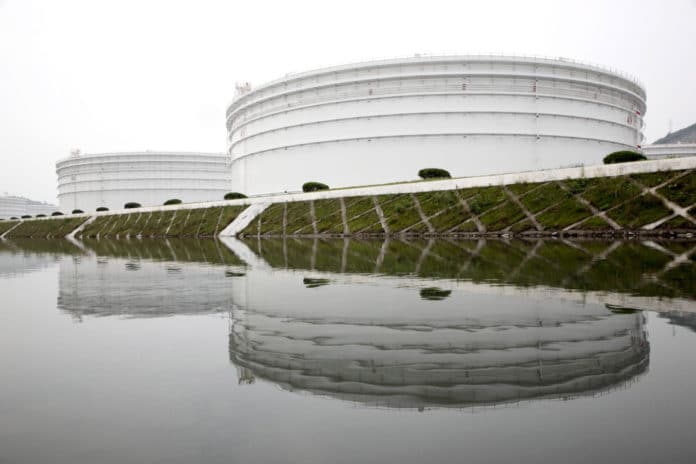China’s got the world puzzling over its oil hoard.
From underground caverns by the Yellow Sea to a scattering of islands in the Yangtze River delta, the government has been stockpiling crude for emergencies in a network of storage sites dotted around the country. Record purchases this year by the world’s biggest energy consumer have helped oil prices recover from the worst crash in a generation. What the country plans to do next could determine where they go from here.
The difficulty is that nobody outside China really knows for certain. The government won’t say how much it’s holding or when the tanks will be full. Energy Aspects says the country will probably keep buying and fill up commercial tanks if it has to, while the likes of JPMorgan Chase say the purchases may soon stop. The difference in opinion is equivalent to about 1.1 million barrels a day, or more than the Asian country buys from Saudi Arabia.
“China seems to feel no obligation to report on its strategic stocks, and that might confer a genuine advantage in its favor,” said John Driscoll, the chief strategist at JTD Energy Services, who has spent more than 30 years trading crude and petroleum in Singapore. “The scope of their purchases can dramatically affect fundamentals and prices. However, since they will likely be shrouded in secrecy, it will remain challenging to quantify the impact.”
China outlined in 2009 its plans to build reserves equivalent to 100 days of net imports. But since then it’s only provided sporadic scraps of detail on its strategic petroleum reserves, or SPR. That stands in contrast to the U.S., where the Energy Department has been detailing data on American inventories for more than three decades.
The Asian country had about 191 million barrels of crude in its SPR as of the middle of last year, according to a statement on the website of the National Bureau of Statistics in December. But it also said at the time that total combined capacity of seven above-ground sites and one location with underground caverns was the equivalent of only 180 million barrels. The figures haven’t been updated since.
The government also said at the time it has leased space in commercial sites, signaling it could buy additional oil while more of its own tanks are constructed. Nobody replied to a fax sent to the press office of the National Energy Administration asking for details about the SPR.
“SPR has been a China mystery due to the lack of government data disclosure,” said Ying Wang, a Hong Kong-based analyst at JPMorgan. The bank estimates the amount of crude China is putting into stockpiles by calculating how much more oil the country is buying and producing than it’s using.
That amounted to about 1.2 million barrels a day over the first half of the year, according to JPMorgan. The bank estimates the country built up a total of about 400 million barrels by mid-2016 out of a targeted 511 million barrels. That means at the current rate of stockpiling, the storage would be filled up by August, leading to a potential drop in imports in September.
Energy Aspects looks at it differently. Because China can shift oil between commercial and strategic storage, the government may be able to increase purchases even if it runs out of its own space, said Michal Meidan, a London-based analyst for the industry consultant. Another 150 million barrels of commercial storage space is coming online by the end of next year that can be filled, she said. That means that while reserve buying may slow, it won’t fall significantly.
“Even if SPR tanks only come online later in the year, more commercial tanks are starting up,” Meidan said. Energy Aspects sees demand for the reserves dropping by only 100,000 barrels a day in the second half of the year to 300,000 barrels daily.
China’s oil imports have averaged an unprecedented 7.5 million barrels a day so far this year, government data show. The purchases, along with temporary production outages in Nigeria and Canada, helped rebalance supply and demand in the market, leading Brent crude, the benchmark for more than half the world’s oil, to jump almost 90 percent from mid-January to June.
In the U.S., supplies in the strategic reserve were at 695 million as of Aug. 26, enough to support 149 days of import protection, according to data from the Energy Department. The government regularly reports how much oil is at each of its four sites and even breaks down the quantity of crude that’s held by sulfur level. When it purchased supplies for the reserve last year, it did so in a bidding system in which the sellers and even the price were publicly announced.
China plans to build emergency reserves equivalent to 100 days of net imports by 2020, the nation’s top refiner said in 2009, citing a plan approved by the State Council. It pushed back completion of the stockpile to beyond the 2020 deadline, according to a Five Year Plan released in March 2016.
“The Chinese seem to embrace the concept of asymmetric information which holds that those in possession of proprietary information and data hold a critical, strategic advantage over the less-informed,” JTD Energy’s Driscoll said.






